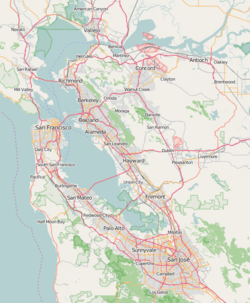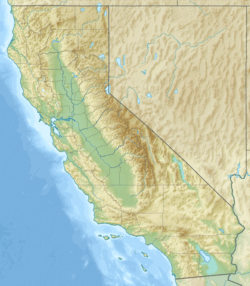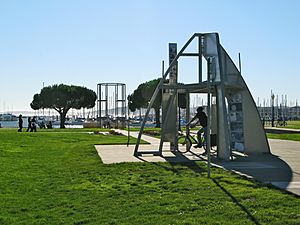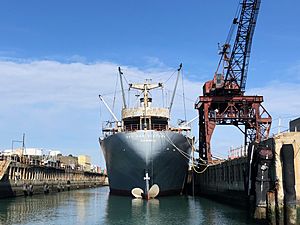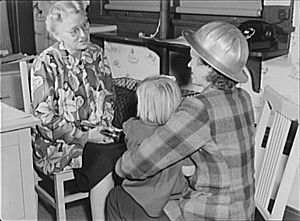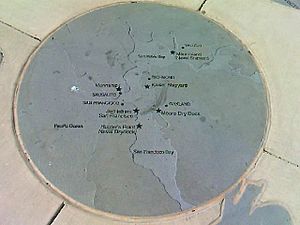Rosie the Riveter World War II Home Front National Historical Park facts for kids
|
Rosie the Riveter World War II Home Front National Historical Park
|
|
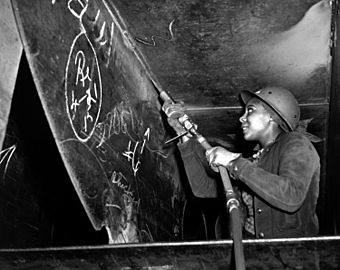
Eastine Cowner, a former waitress, working on a ship
|
|
| Location | Shipyards of Richmond, Richmond, California |
|---|---|
| Area | 145 acres (59 ha) |
| Website | Rosie the Riveter WWII Home Front National Historical Park |
| NRHP reference No. | 01000287 |
Quick facts for kids Significant dates |
|
| Added to NRHP | January 31, 2001 |
| Designated NHP | October 25, 2000 |
The Rosie the Riveter World War II Home Front National Historical Park is a special park in Richmond, California, near San Francisco. It helps us remember and learn about what life was like in the United States during World War II. This park focuses on the "home front," which means all the efforts people made at home to support the war.
The park shows us places like the Kaiser Richmond Shipyards and the Victory ship SS Red Oak Victory. It also includes old factories and housing areas. A big part of the park's mission is to honor the important roles of women and African-Americans in the war industries. They worked hard to build ships, tanks, and other supplies.
This park is a "partnership park." This means the National Park Service helps manage it, but they don't own all the land or buildings. The park was created in 2000 and is still growing. Bus tours started in 2007 to help visitors explore the different sites.
Contents
Park Attractions
The park has a visitor center inside the old Ford Building. Here, you can see exhibits about Richmond's wartime industries and the people who worked there. There's also a film that shows what the "home front" battle was like. Park rangers are there to answer questions and lead tours.
You can also take a self-guided car tour, with optional walking parts. In 2007, bus tours began. These tours had local residents on board who shared their own stories from the war. This helped visitors understand the history of everyday streets.
The Rosie the Riveter Memorial is open every day from morning until night. Other city parks within the National Park's area are also open during these hours.
Rosie Memorial
The idea for this park came from building a Rosie the Riveter memorial. This memorial honors the "Rosies," who were women who worked in the shipyards during the war. Richmond had four shipyards that built 747 ships. This was more than any other shipyard area in the country.
Richmond was also home to 56 different war industries. The city grew very quickly, from 24,000 people to 100,000 people almost overnight. This caused big problems with housing, roads, and schools.
The memorial was built at Marina Bay Park, where Kaiser Richmond Shipyard #2 used to be. It is shaped like a Liberty ship being built. A metal pier looks like the back of a ship, a cylinder is the smokestack, and the front of the ship is made from parts like those assembled by workers. Along the walkway, there is a timeline of World War II. Signs explain the history of women, workers, and the home front.
Ford Richmond Plant
The Ford Motor Company Assembly Plant in Richmond was the biggest assembly plant on the West Coast. It was one of only three places in the country that processed tanks. About 49,000 jeeps were put together here. Also, 91,000 other military vehicles were prepared for use.
Ford hired thousands of workers during World War II. Many of them were women who were working outside the home for the first time. The song "Rosie the Riveter" was written about these women.
During the war, the government and private companies worked very closely together. This was a new way of working. It helped create what later became known as the "military-industrial complex" during the Cold War. This means that the military and big industries often work together.
A famous architect named Albert Kahn designed the Ford plant. After World War II, Ford moved its factory to Milpitas.
Today, the old Ford plant building has been fixed up. It now has many different businesses, along with the park's visitor center.
Richmond Shipyards
The four Richmond Shipyards were part of the Kaiser Shipyards. They built 747 ships during the war. No other place in the world has built so many ships, so quickly. The park's Rosie memorial is located where Shipyard No. 2 used to be. Shipyard No. 3 is listed as a historic place.
Workers at these shipyards built both Liberty and Victory ships. They finished these ships much faster and cheaper than other shipyards. For example, the SS Robert E. Peary was put together in less than five days! By 1944, it took only a little over two weeks to build a Liberty ship using normal methods.
SS Red Oak Victory
The SS Red Oak Victory is a Victory ship that has been saved as a museum ship. It was one of 414 Victory ships built during World War II at the Richmond Shipyards. This ship was special because it was moved from the Merchant Marine to the U.S. Navy.
During 1945, the ship delivered supplies and ammunition to other ships in the fleet. It worked in the Pacific Ocean and handled many tons of ammunition. Even though it was a dangerous job, the SS Red Oak Victory supplied the fleet without anyone getting hurt.
Atchison Village Housing Project
When so many workers came to cities like Richmond, there was a huge shortage of housing. People had to find any place they could to sleep. Some slept in movie theaters all night. Others shared "hot beds," meaning one person would get out of bed, and another would immediately get in. Some even camped outside.
The Atchison Village Housing Project is an example of how local and Federal governments worked together. They built much-needed homes for war workers and their families. These simple wooden buildings show how they had to save time, money, and materials during the war.
A law called the Lanham Act of 1940 provided money to build about 625,000 homes across the country. These homes were very popular. Company managers were often the ones who could get housing in Atchison Village.
Sadly, because of unfair treatment, many minority groups had a very hard time finding housing. They often lived in shacks, in large wooden crates, in trailers, or even in their cars. Other workers with lower incomes were lucky if they could move into dorm-like buildings built for the many World War II workers.
The Richmond Housing Authority was the first in the country to manage a defense housing project. Atchison Village was one of 20 public housing projects built in Richmond during the war. It was built in 1941 and is the only one funded by the Lanham Act that still exists in Richmond today.
Today, Atchison Village is a group of houses owned by people who live there. They manage the community together. While most of the temporary housing from World War II is gone, Atchison Village, which was built to be permanent, is still here.
Kaiser Richmond Field Hospital
Before the invasion of Europe in June 1944, more Americans were dying in accidents at home than on the battlefields of World War II. Henry J. Kaiser, who started the Richmond Shipyards, knew that his workers needed to be healthy to build ships on time. He started a new idea: pre-paid medical care for workers. This meant workers paid a small amount regularly, and then their medical care was covered. This idea soon grew to include families too. For many workers, this was the first time they had ever seen a doctor.
The Kaiser Richmond Field Hospital for the Richmond Shipyards opened on August 10, 1942. It was paid for by the U.S. Maritime Commission.
By August 1944, most Richmond shipyard employees had joined the plan. It was the first large-scale plan in the country where people paid in advance for group medical care. By 1990, Kaiser Permanente was the largest non-profit health organization of its kind.
The Field Hospital is a single-story wooden building. It has a simple, modern design, partly because materials were limited during the war. The Field Hospital worked as a Kaiser Permanente hospital until 1995, when a new hospital was built downtown.
Maritime and Ruth Powers Child Development Centers
The Maritime and Ruth Powers Child Development Centers were two of about 35 nursery schools in the Richmond area during World War II. These centers provided child care for women who worked in the Kaiser shipyards. The Maritime center was built and paid for by the Maritime Commission. It was part of a bigger project that also included housing, an elementary school, and a fire station. The temporary housing was taken down after the war, but a larger permanent housing complex and the other buildings are still there.
The Maritime Child Development Center was a wooden building with a modern style. The Richmond School District ran it. It offered new ways of teaching and had nutritionists, psychiatrists, and certified teachers. It could care for 180 children each day. At its busiest, Richmond's citywide child care program cared for 1,400 children daily. This was when 24,500 women worked for Kaiser. Unlike earlier government-funded daycares, these World War II centers were for working mothers, not just for very poor families.
The Kaiser-supported Child Care Centers became known for their new ideas and high-quality child care. The center is still open today.
Lucretia Edwards Shoreline Park
Lucretia Edwards Shoreline Park is named after Lucretia W. Edwards, a local community leader. This park honors the important work done by the Bay Area Shipyards during World War II.
Besides the local Richmond Shipyards, the park has footprints of shipyard workers with plaques in the sidewalks. Long, low walls point visitors to other Bay Area shipyards.
These words are carved into the concrete walls:
- Bethlehem San Francisco – This shipyard was the only private one in the nation to fix submarines. It repaired 31 submarines in two years.
- Moore Dry Dock – This shipyard handled difficult jobs like building, fixing, and changing ships.
- Hunter Point Naval Dry Dock – Hunter Point repaired 600 fighting and support ships.
- Mare Island Naval Shipyard – Mare Island built more than 400 ships. It set a record for building a destroyer, the USS Ward, in just 17 and a half days. This record was never broken.
- Marinship – The 75,000 Americans who worked at Marinship during the war built 93 ships.


